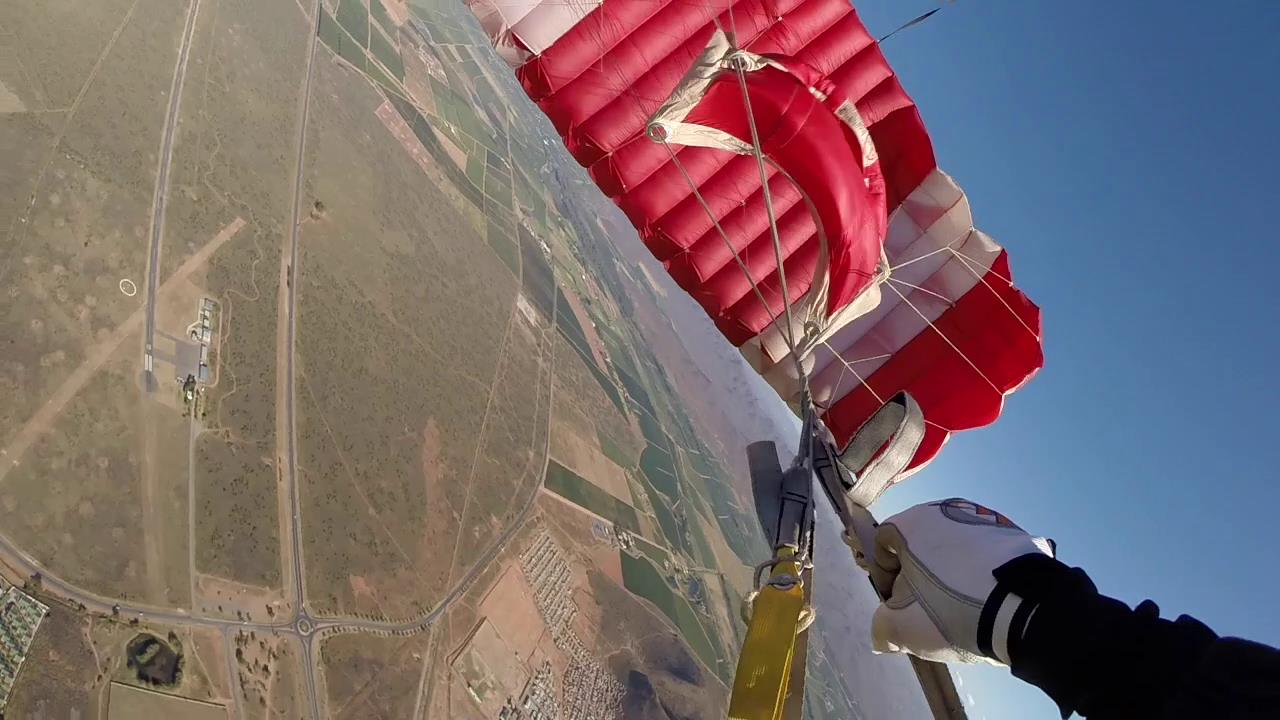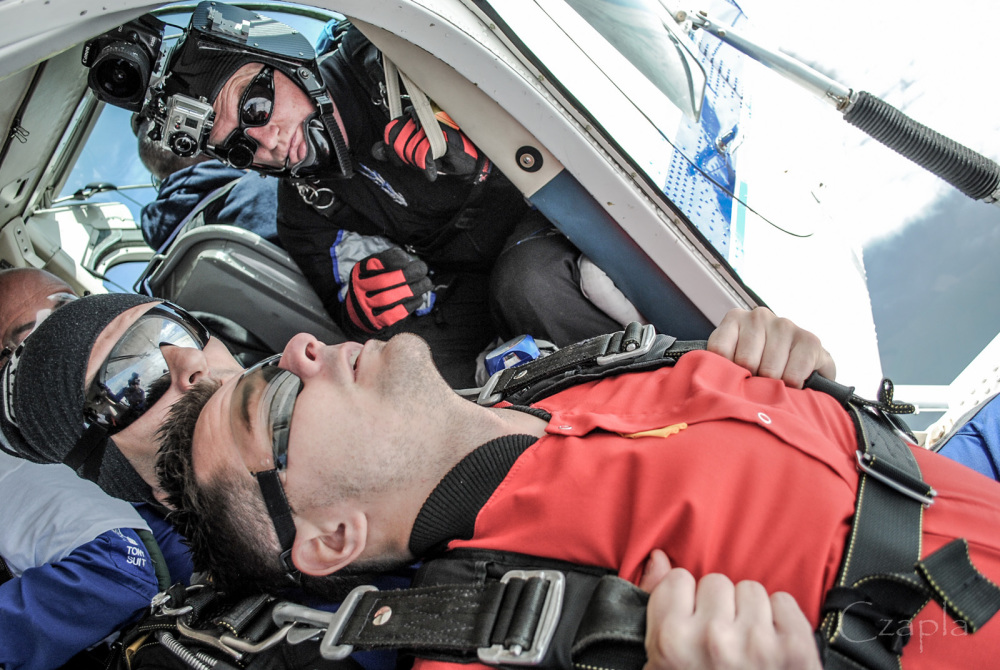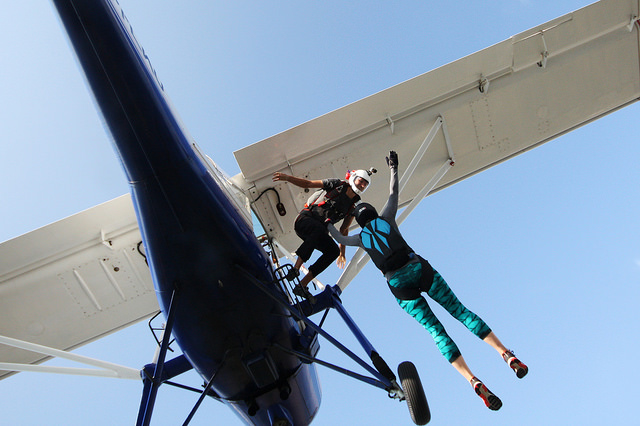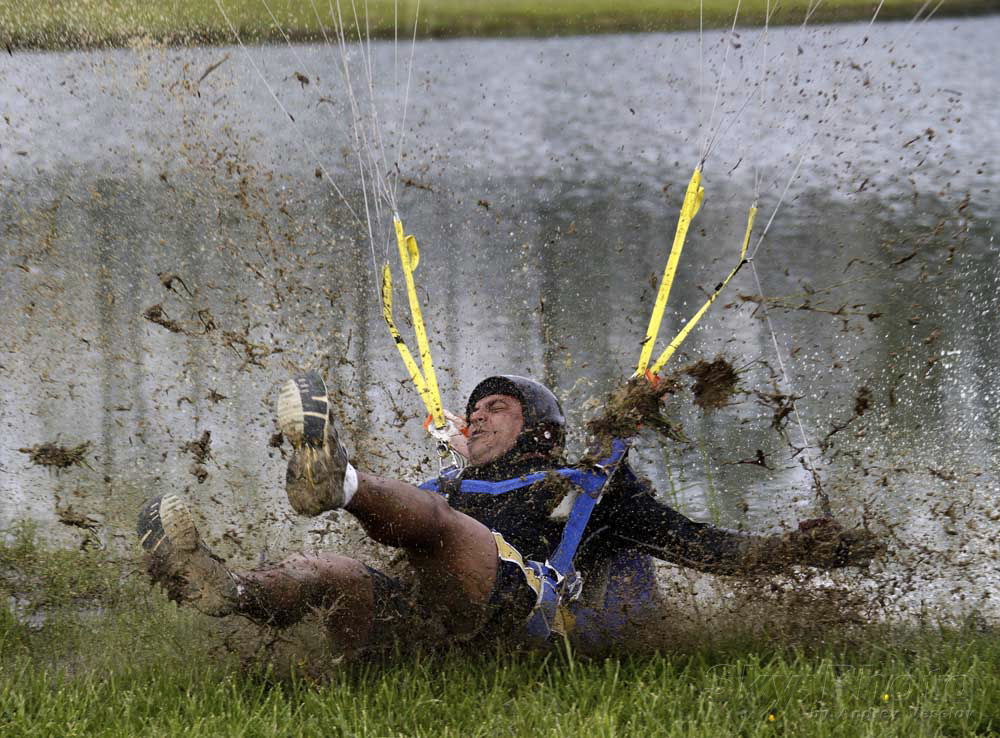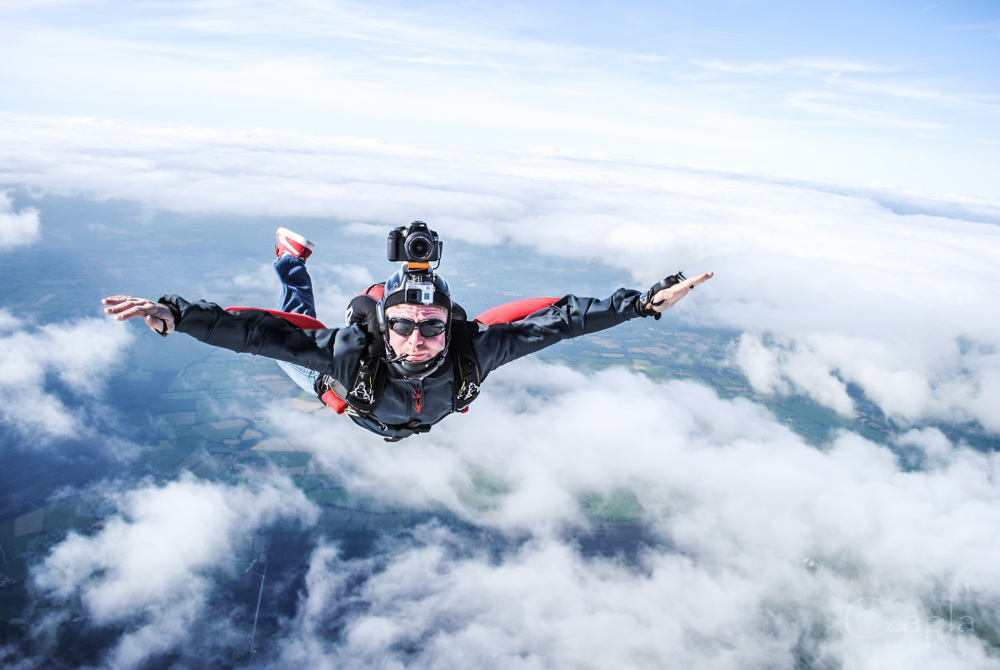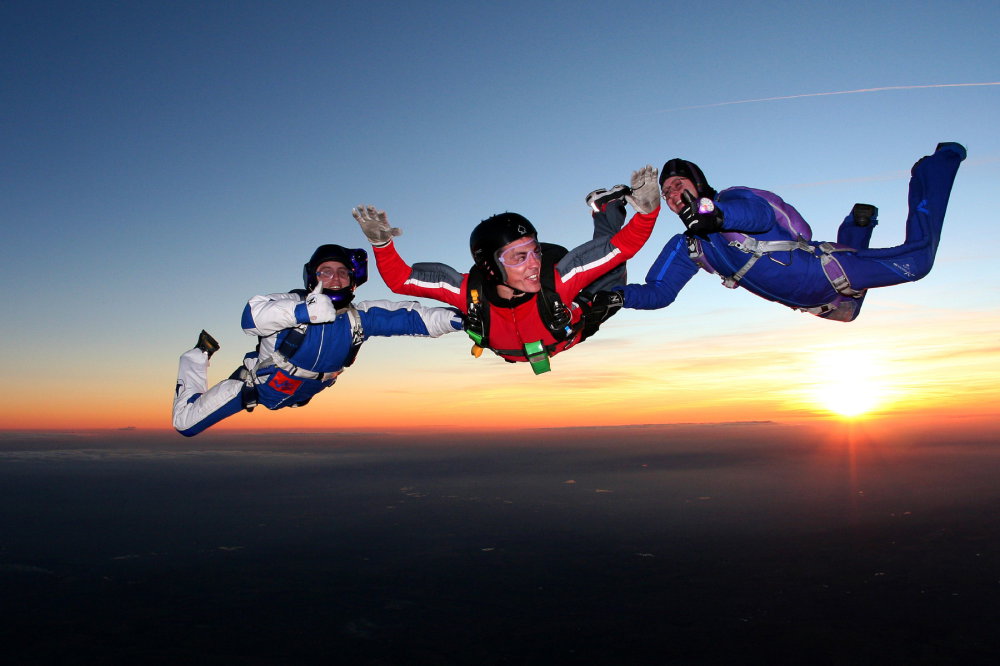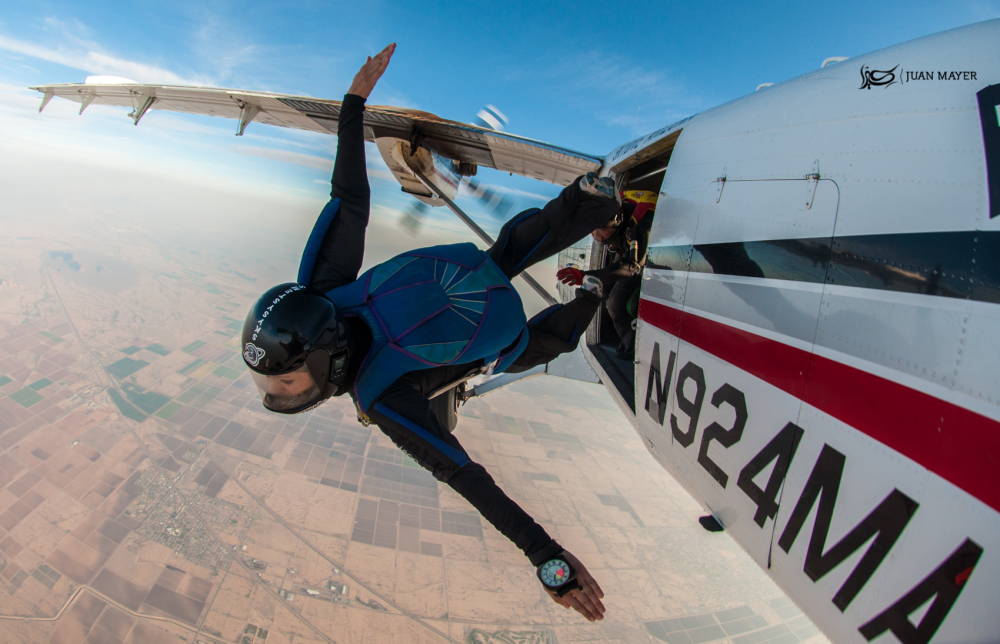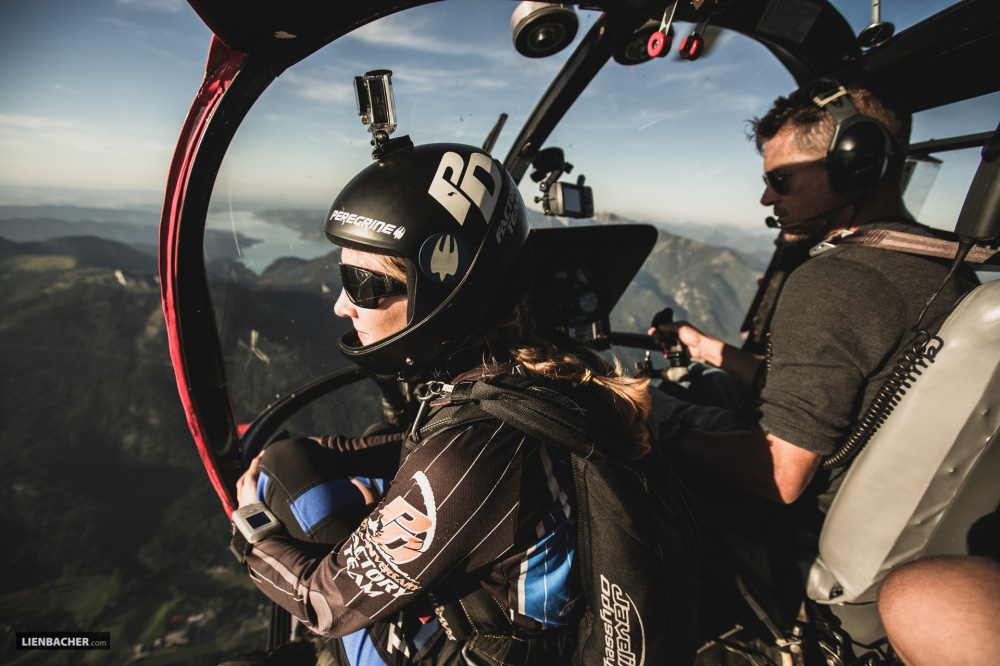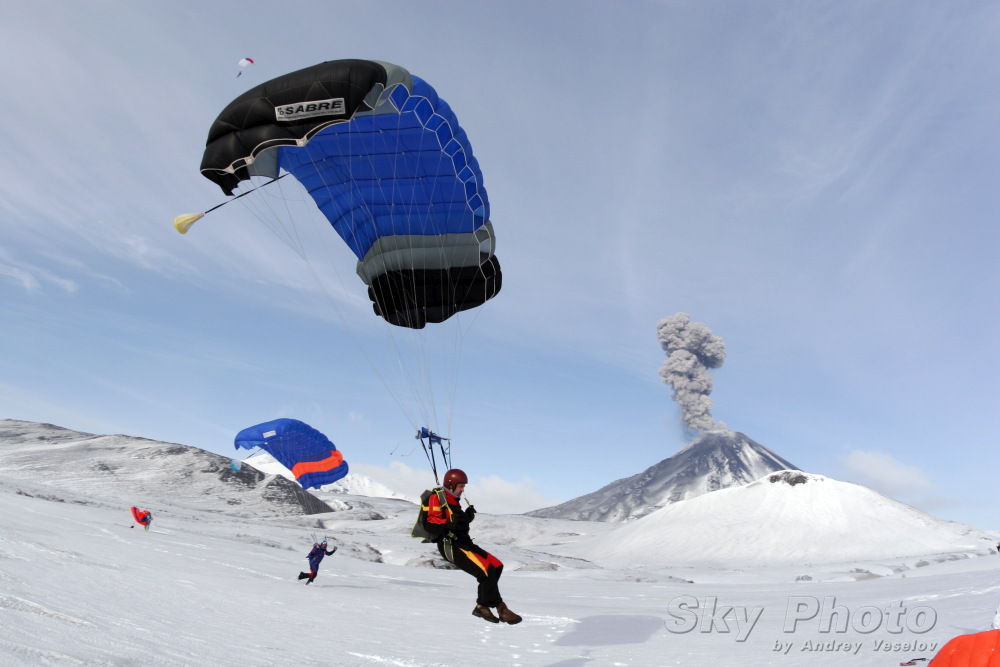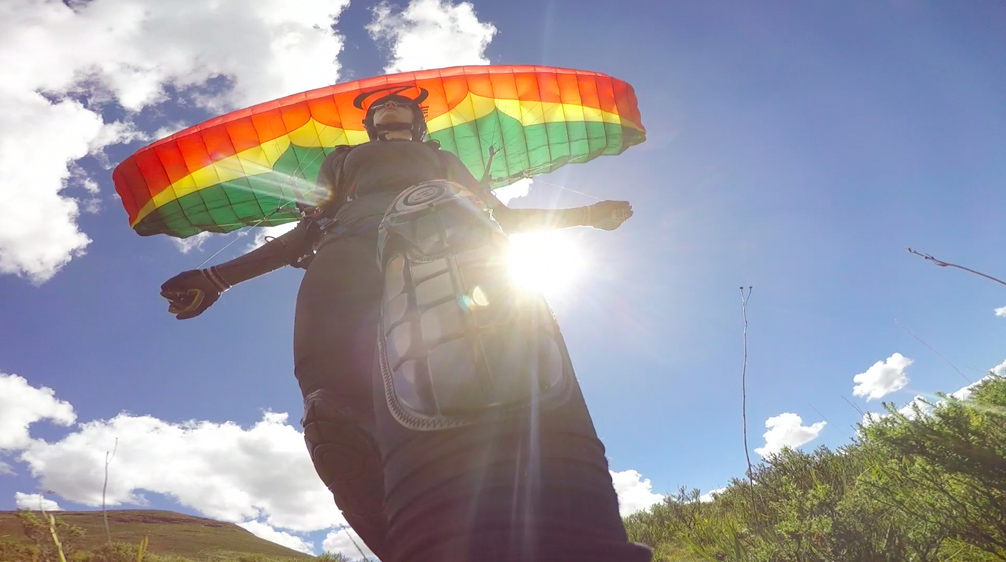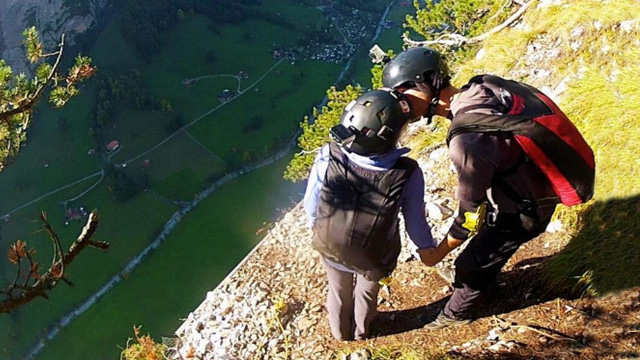-
Content
27 -
Joined
-
Last visited
-
Feedback
0%
Content Type
Profiles
Forums
Calendar
Dropzones
Gear
Articles
Fatalities
Stolen
Indoor
Help
Downloads
Gallery
Blogs
Store
Videos
Classifieds
Everything posted by nettenette
-
How to Avoid Spinning Malfunctions Image by Oliver NöthenAh, to be swung madly around the ballroom of the sky. If you like that sort of thing, of course. Most of us, y’know, don’t. Even though they’re eminently preventable, spinners remain a very statistically significant cause of cutaways. There’s good news, however: A little attention will go a long way towards making sure you aren’t dancing downward under a misbehaving main. Here’s how to get your body, brain and gear set up right. 1. Are you bungling the basics? If spinning mals come up more than occasionally for you, consider whether you need to send yourself back to packing (or body-position) school. Might be the case. 2. Are you just being loopy? Back when side ponytails were sexy and just about everything smelled like Teen Spirit, the skydiving industry used Velcro to secure toggles to risers. When manufacturers made the switch to the velcro-free designs we see now, they forgot about something vitally important: the long, floppy bights in the steering line that were now suddenly exposed to the rodeo ride of the deployment process. Those mile-long bights took the opportunity to lasso anything they could. A particular favorite: hands. One misplaced toggle grab, and a skydiver could easily find him/herself in a compromising bondage situation with their control lines. The bights happily welcomed guide rings into the act. It was a ready-made recipe for a super-solid spinner, and it was ugly. Soon, every single manufacturer’s rig designs had integrated line stowing features (“keepers”). There’s a reason the changes were made: as a jumper, you need that line tucked safely away until you’re good and ready to release the brakes. That said: Many of those old risers are still around, unmodified. Even more bafflingly, some skydivers don’t bother stowing the lines during the packing process (presumably, to save 20 seconds or so). If that’s you, you know what to do. And if you have Velcro on your risers, for the love of god check it for airworthiness. 3. Are your cat’s eyes conspiring against you? Toggles love the cat’s eyes of brake lines. They dive at the chance to snuggle and lock in a spinny embrace. It’s no wonder that’s the case: after all, their relationship is really hot. The heat that’s generated by the slider’s travel over the lines has a shrinking effect on the system, creating a kind of Chinese fingertrap for your toggle seating. With one toggle in and one toggle out, you’re going to be going for a ride. A rigger can quickly suss out if your cat’s eyes are in good shape: big enough for the toggle to pull out smoothly, but not so capacious that the toggle’s fat bits can pass through. If they need replacing, do it. 4. Do you know when to let go? Spinning malfunctions are sneaky bastards. For all their preventability, they have killed people. Make no mistake: Once you’re looking at one, you need to take it seriously. The most important thing you need to remember is this: a spinning malfunction is not a line twist. When you’re under a docile, level main that’s flying cheerfully along as you swear at it, you’re looking at a line twist. When you’re not directly below a canopy that’s flying level -- when it’s flinging you outwards as it heads for the ground -- you are on the business end of a spinner. The first is an inconvenience. The latter is a mal, and you’d better get on it. As wing loading increases, so does the violence of the spin, and the likelihood that you’re going to kick out of it quickly dissolves. So: Don’t fight it. Just get rid of it. Take some quality time with your reserve. You’ll be glad you did.
- 6 comments
- 11
-
- canopy control
- safety
-
See more
Tagged with:
-
What Skydivers Don’t Know About The Holes in the Sides of Their Heads Image by Lukasz SzymanskiThere are plenty of things in this life that you don’t want to hear. I know. Your girlfriend telling you she’s leaving you for her co-worker who buys roses instead of jump tickets. The wind tunnel peanut gallery tittering at your epic layout biff. The dude at the bonfire yammering on about his siiiiiick proxy flight in his brand-new sponsored Air Mattress 4. But what if you never got to hear anything at all anymore? And what if it was your fault? If you want to keep the good sounds coming in to your skyward-tilting brain, you’d better take some responsibility. There are probably some things you don’t know about the holes alongside your head, after all. 1. Hearing loss is forever. Once you’ve damaged the lining of your inner ears, there’s nothing that can be done to bring it back. There’s no medication to bring your old ears back -- nor is there a surgery that sets things straight. Hearing loss that’s attributable to skydiving happens because of damage to the cilia of the inner ear. (Cilia are the tiny, hair-like cells that vibrate with the pressure of sound waves and tell the brain about it.) Too much exposure to those waves wears them right out. Once they can’t wiggle anymore, it’s over. They don’t bounce back. 2. You might go crazy, too. Alongside general hearing loss, you might get a bonus symptom: tinnitus. If the cilia are bent or broken due to excessive sound exposure, they can dribble out random electrical impulses to your brain, causing you to hear sound where none exists. Basically, this results in a constant ring/roar/buzz/hiss/squeal that lives inside your head 24/7. If that sounds like hell, you’re absolutely right. 3. It’s louder up there than you think. Decibel levels are not linear; they’re logarithmic. Linear measures are measured with addition and subtraction (for example: four miles is twice as long as two miles). Logarithmic measures ratchet up by factors of ten. This means that every increase of 10 on the decibel scale represents a 10-fold increase in the intensity of the sound it measures. Noise that clocks in at 20dB is 10 times louder than a sound of 10dB. 30dB? 100 times louder...so look differently at decibel measures than you do at the numbers in your bank account. The noise we’re subjected to on the ride up hovers over 90dB -- which government standards decree is only healthy for around seven and a half minutes. We’re in the tin can for 20-30. You do the math. 4. Monotony is worse than variety. I used to produce music videos for a living (which is less fun than you’d think, but that’s another, boozy story). The production team was always required to provide the crew and talent with earplugs; if the production assistant forgot them, it was crucifixion time. That’s because OSHA, the US Occupational Safety and Health Administration, enforces requirements limiting workers’ exposure to a time-weighted average noise level of anything over 85 dB. As skydivers, we don’t have to listen to that same damn godawful excuse for a song over and over (thank god), but we’re actually exposed to something that’s actually worse for our health than boy bands: level monotony. A long exposure to a same-pitch drone -- such as engine noise -- is more damaging than sounds that change in pitch, like loud music. The droning sound wears away at the cilia with the same sound waves, like waves crashing on the same part of a beach over and over in the same way. 5. You can plug your holes. Many skydivers wear earplugs from gear-up to landing. Some take them out for freefall; others take them out for the canopy ride. Figure out what works for you and allows you to reliably receive information from your audible. It takes some discipline (or self-tricksiness) to remember, but it will help you in the long run. Try keeping a pair taped to your altimeter to help you remember to put them in. Helmets with padding over the ears are less effective than earplugs, but they can still help. 6. You don’t need expensive earplugs to skydive. The drugstore cheapies will do. When you place them, make sure they’re snug -- but that you can still feel them move around when you slide your jaw around (so you can equalize pressure, if necessary). 7. You can still pretend you can’t hear. When Siiiiick Wingsuit Proxy Guy looks at you, ever hopeful for adulation, you can still give him back a confused “huh?” and wander off. Better yet: take your earplugs to the bonfire.
-
How to Set Yourself Up For Success Image by Joel StricklandIt’s time. You’re ready. You’re going to point your belly button away from the ground when you fall out of a plane. YES. You’re gonna point it at the horizon. You’re going to point it at other people. You’re going to sit around and look at it while you slide backward. You’re going to take your belly button on an amazing adventure. But wait: is your container ready to join you on this journey? The discipline you’re about to enter -- freeflying -- makes more demands of your skydiving rig than belly flying does. Now that you’re going to start moving around at a full range of angles in the relative wind, you need freefly-friendly equipment. But what is a freefly-friendly skydiving rig? The simple answer is that it’s a skydiving container, with all of its flapping bits under control, that fits close to your body. To get a little more specific, we’ll look at a few examples of non-freefly-friendly rigs -- and we’ll see how to get them fixed. The “Reclining Chair” What’s the difference between making a great skydive and hanging out in a poolside sun lounger? Uh...everything. If your leg straps are slippy, your sitfly might end up looking like a lounge-fly -- and the resultant harness ride-up might put your chest strap into your throat. SO importantly, this look is also humorously unflattering in photos and videos. This might be the easiest issue to fix -- it could be a simple issue of improper strap adjustment. Before you send your kit in for surgery, see your S&TA;, rigger or instructor to check your current gear-up method and adjust accordingly. If it’s truly an issue of fit, your rigger can amend your harness, leg pads and leg straps accordingly -- and add one of those fetching little butt-bungees to keep your leg straps managed. The “Incredible Floating Container” If the laterals on your rig are too long or the leg straps are too loose, you’re going to have one of these -- a container that floats away from your freefallin’ body while air rushes in to separate the two of you. The fixes for the Incredible Floating Container are similar to the Reclining Chair -- first, check with an expert to make sure you’re kitting up correctly; then, if the problem persists, send it to the loft. The “Flippy Floppy Flapper” Guess what? Your pin flaps -- and riser-cover flaps -- love to flap. They just love it. They’ll use any excuse to get out there and do their name proud. To keep the flaps under wraps, you’ll need to look closely at the condition of each component. Make sure the stiffeners aren’t broken, warped or loose. Check for weak Velcro and/or magnetic closures. If you find something, don’t despair: Your rigger can revitalize wiggly tuck tabs, replace ragged-out Velcro, install (or replace) magnets and/or repack your reserve to adjust where its bulk places pressure on the system. The “Premature Popper” If your BOC doesn’t hug your pilot chute snugly enough, the multi-orientational pressures of freeflying make it much more likely that said pilot chute is going to make an early escape. Even if you’ve gone ahead and bought yourself one of those fancy low-profile freefly puds, that’s not going to save you if your BOC is loose, holey or inelastic. Note: if you’ve recently downsized in addition to switching up your discipline, be extra careful -- the BOC system relies on a snug, correctly-fitting main in the tray. Another pop-preventer: maintaining a frayless closing loop of the proper length. The “Put Me In, Coach” The Put Me In, Coach is another variation on the Premature Popper. It’s an even less-fun one: an instantaneous reserve ride without the screamy good time of a malfunctioning main. It happens when the Velcro on your handles is weak, or when you bumble into a limb or foot that grabs your D-ring. Make sure that the Velcro on your handles is strong and mated completely on both sides. It should take a moderate tug to separate the handle from its cozy home. Also: it’s not necessary to replace your D-ring with a pillow when you transition to freefly, but there’s a reason it’s so commonly done: that capital D is a big, shiny, shoe-sized liability. The “Velveteen Rabbit” If your rigger tells you that your rig is impossible to freeflyify, you may be the soon-to-be-ex owner of a Velveteen Rabbit rig. Don’t be too sad: it has probably been very loved for very many years, and it’s ready for retirement. Give it a viking funeral if you want, but don’t insist on flying it -- let it go. Making the hard choice to get rid of it might just save you -- and your wandering belly button -- a lot of unnecessary misery.
-
A Spa Day For Your Skydiving Rig Image by Andrey VeselovCharlie Chaplin has nothing on you. That landing was nothing less than *art*. You managed to use that doofus downwind setup to milk every last opportunity for comedy out of your return to earth. You nailed the exaggerated “uh-oh” expression. You executed the perfect shortbus flare. You transitioned majestically from a banana-peel touchdown to a ten-foot skid through the one spot of mud in the landing area. You, my friend, are awesome. Now, you’re going to have a nice laundry day. Here’s how. Wait for it.If you’ve managed to drag your beautiful gear through the mud, you’re going to have to stare at it in shame for a while before you make a move. Wait for it to dry completely -- which may take a couple of days -- then scrub off what you can with a dry brush. Take it apart.Remove both canopies from the rig. (Do this after performing a practice reserve deployment -- as you always do before a repack, right?) Remove your AAD from the rig. Remove all hardware: reserve handles, risers, RSL, hook knife, etc. If you’re not comfortable doing this yourself, ask for help from a rigger. Treat your rig like a dog....or, at least, like you’re administering a doggie bathtime. Gather a big plastic tub, gentle detergent (such as Woolite or castile soap) and a nylon scrub brush. Fill the tub about halfway with lukewarm -- not hot -- water. Dunk your empty rig and agitate it in the soapy water, but don’t let it sit and soak. After the container is fully saturated, go at it with your scrubber. Repeat the dunk-and-shake cycle. Once your rig is good and scrubbed, empty the tub and refill it with soapless, lukewarm water. Dunk and dunk and dunk, emptying and refilling the tub as necessary, until not even the tiniest hint of soap remains. (Dried-on soap is a filth magnet.) ...Or treat your rig like fine lingerie.You can machine-wash a rig, but you’d better make sure you act like it’s a set of ridiculously fancy, spendy underthings. (Ridiculously fancy, spendy underthings with hip rings, of course, that need to be strapped up with athletic tape to keep them from denting the inside of your machine…) Put your empty, hardwareless, Velcro-mated rig in a mesh laundry bag and run it with gentle detergent on the delicate cycle. String it up.Hang your wet skydiving container in a dry place that isn’t exposed to direct sunlight. As you get it set up, straighten every flap and fold to prevent wrinkles from locking in. Keep tabs untucked. If your rig has Cadmium hardware, you’ll need to do a thorough hand-drying pass with a towel at the very beginning to prevent rust. Stop time.Okay. You can’t stop time. You can, however, encourage the time between cleanings to maybe slow down a little bit. After your rig is spotlessly, white-glove-test-ready, make-your-mama-proud clean -- and as dry as the beer truck at the end of the Skydive Arizona Christmas Boogie -- you can apply a single coating of fabric protection, such as Scotchgard, to shield it against redirtying. Check the manufacturer’s recommendation for application before you get all spray-happy. That said, the general advice is to apply three whisper-light coats of protectant, making sure each coat is dry before applying a new one. Make sure you do this in a well-ventilated area (lest you waterproof your lungs). Get out, damned spot.Keep a baggie of stain-removing wipes in your skydiving gear kit. They’re a lifesaver for little oopsies. Take a canopy course....or start working at a laundromat to save money. Your call, Charlie.
-
Image by Ralph TurnerYou probably have one meaningful interaction with your AAD: you chase the red light. Poke, poke, poke, watch. ...Zero. Okay. Off you go. Just a quick note, friend: you might want to poke a little deeper. According to the USPA, there have been no less than nine fatalities related to AAD fires at designated firing altitudes that did not result in fully inflated canopies before impact. The point is that these guys chased the red light just fine, but there was likely a difference between what the AAD was told to do and the actual conditions of the jump. A couple hundred extra feet could have made the difference between nine annoying repacks and nine funerals. Food for thought, y’know. If your equipment is new-ish, your AAD probably has a feature that allows you to change its activation altitude. It’s good to know that feature exists, and it’s good to know how it works -- because it helps you understand that mysterious little whatsit in your rig a little better when you do. If you’re ready to explore, do a little introspection first. Here are the important questions to ask yourself before you change the activation altitude on your AAD: 1.Do you want this to be forever, or just-for-now? Most currently manufactured automatic activation devices let you offset the device’s activation altitude to allow for a one-time altitude differential between takeoff and landing area. This will be a factor for you only if you’re making a single wahoo at a dropzone with a significant altitude differential between takeoff and LZ -- or if you’re doing a demo jump with an offset. This method resets when the device turns off. If you need a change that sticks around a little longer, don’t despair: both the Cypres 2 and Vigil 2+ have a way to increase the activation altitude until you change it back again. Your owner’s manual will explain how to do this. 2. What’s the difference? The Cypres 2 adjusts in increments of 100 feet, from 750 up to 1,650. The Vigil adjusts in 150-foot increments. For example, if you have a Cypres you’ll add increments +100 feet for a higher landing zone compared to the take-off and increments of -100 feet for a lower landing zone. 3. When’s it going to give the all-clear? When you make a positive altitude correction, the AAD will still disarm at its standard number of feet above the ground zero reference -- the exact same altitude as it does when no altitude correction is set. When a negative altitude correction is applied, however, it will disarm at its standard number of feet above the preset negative altitude correction -- the new landing zone. 4. How forgetful are you? If you’re the type of person to run into sliding glass doors at full clip, wear your shirt inside-out all day and/or infuriate your spouse/partner/lover by brainfarting every single anniversary, beware: Adjusting the activation altitude on your AAD might not be the best idea for total space cadets. To avoid a two-out, you’re going to need to remember that setting and ensure that you’ve got an open, functional main no lower than 1000 feet above it. Remember: a slow opening messes with that margin. Think about density altitude, and think about your packing choices. Another liability for nutty professors: turning on your AAD in the landing area of one dropzone and driving to another dropzone with a different altitude without resetting the AAD. (Work out how much of a kerfuffle that could be.) Finally, balance your know-how with your need. Bryan Burke, Skydive Arizona S&TA; (and über-adventuring renaissance man) has this to say about it: “I’m willing to bet that, for most skydivers, messing around with an AAD is likely to cause more problems than it’s going to solve.” 5. Which way are you pointing your belly button? You may be surprised to know that your body position directly affects your AAD’s activation altitude. AADs work using the metrics of measured air pressure and measured time. Those two parameters allow the little guy to calculate your pretty-much-exact altitude (±3 feet or so) at any given moment as a function of the registered air pressure, as well as your vertical speed related to a pressure variation within a certain period of time. But wait! Does that air pressure change depending on where your body has oriented that little AAD? Why, yes. Yes it does, smartypants. A belly position puts your AAD in a burble. This changes the atmospheric air pressure registered by your AAD by up to 10 millibars. Interestingly, that works out to a difference of ±260 feet. In an AAD activation scenario, 260 feet is y’know kindof a big deal. The AAD senses that the belly-to-earth jumper is higher than they actually are -- kinda like a policeman working the exit road of a music festival. Be aware. 6. Why do you even have this little gadget? If you have an AAD in order to make your skydiving life painlessly safer, you need to know that it’s not the foolproof set-it-and-forget-it piece of furniture you might think it is. You put so much faith in that thing that you really ought to get to know it a little better. There will, after all, likely be a fatality number ten...and it doesn’t have to be you.
-
How Not To Become Dog Food Like That Indiana Jones Guy Image by Lukasz SzymanskiRemember that scene in Raiders of the Lost Ark? Indiana Jones is on an active airfield. He’s duking it out with a bald, mustachioed, wall-of-meat Nazi, and he’s kinda losing. Finally, he manages to distract the dude with his puny, tickly little punches until a propeller can chop his shiny evilness into dog food. And we cheer, and we laugh. Because ha! That guy was so stupid, he didn’t even see that propeller. Hilarious. Well, my friends -- we could all easily be that bald, mustachioed, wall-of-meat Nazi if we’re not careful. We’re around propellers all the time, after all. We’re accustomed to hearing and feeling them -- so much so that they’re almost invisible. Statistically, we’re in their immediate presence enough for the risk to be proportionately higher than it is for someone who’s rarely on an active airfield. So: here’s your game plan. Always sneak up on fixed-wing aircraft from behind. Props are located in on the fronts of fixed-wing aircraft -- either on the nose or on the fronts of the wings themselves -- so always approach a fixed-wing aircraft from well behind the wing. Teach yourself to do this every time, whether or not the plane is running. This will lessen the chance of you bumbling into the “fool processor” with a boogie beer in-hand. Always stare helicopters in the face. (Kinda.) Helicopters don’t like to be snuck-up-on. Think about it like you’re establishing dominance -- always approach helicopters from the side-front, where the pilot can see you. (The real reason for this is the danger posed by the rear rotor, but -- if you think about it -- helicopters kinda have faces you can stare down.) The rule of thumb is to stay in front of the boarding door, never behind it, and not directly in front of the helicopter where it tips during takeoff. Never chat with the pilot from outside the plane. Have manifest radio them with information, or -- if you must -- do the annoying half-gesture, half-shout thing inside the cabin. They probably don’t want to talk to you, anyway. Never touch a propeller unless you’re filling out a timecard to do it. Touching a propeller is like sticking your hand into a beehive. You may or may not get stung, but it’s an inarguably dumb idea. Even if the plane is tucked in for the night, it’s not okay to saunter up to a propeller and stroke, push, spin, crank, pull, lean, poke, lick or fistbump it. They’re heavy, sharp and kinda unpredictable, especially if you’ve been drinking (which you probably have been). Just leave it alone. Don’t take the shortcut. Is the shortest distance from the LZ to the hangar a straight shot through the loading zone (or any other aircraft operating area)? Do the right thing and walk around it. If you start cutting through the no-walk zone to save a couple of minutes, your fellow jumpers, students and spectators will likely follow suit. Restricted areas aren’t restricted unless it’s hot and you’re tired and you double-manifested, and you -- or someone who waddles along after you -- might pay a high price for the choice. Don’t wave your hands in the air like you just don’t care on a heli huck. ...until you’re either hanging from the helicopter strut, safely landed, or mugging for a freefall photo you’ll be embarrassed about later. There are spinning scimitars up there while you’re exiting, dude. Do your part to muddy up the gene pool. Especially on crowded weekend days, boogies, demo events and any other place that more than two mouthbreathers are gathered in the name of skydiving, you are going to witness stupidity. If you see one of the horde wandering cow-faced towards the propellers -- almost always, led by a GoPro or smartphone -- please grab them, divert them and ask them nicely not to procreate as you lead them gently behind the signs they’ve so blithely ignored. Maybe remind them of the bald, mustachioed, wall-of-meat Nazi guy who became dog food. (Everybody remembers that part.)
-
Image by Lukasz SzymanskiHeadin' into twilight Spreadin' out her wings tonight She got you jumpin' off the deck And shovin' into overdrive... When I was learning to wingsuit, I sang it in my helmet. Every time. True story. Anyway. We can all agree that -- in addition to fun, of course -- skydiving is about pushing personal limits and building personal skillsets. We might also agree that skydiving is not necessarily about putting yourself directly in the path of actual mortal danger. There are inherent risks (and, if we’re being honest, we kinda love them), but we don’t love the idea of spending a couple of seasons healing up from a broken pelvis. Right? Right. There are multiple danger zones in skydiving, and it’s actually something of an autobahn -- in that there are no posted speed limits to reach them. To put it another way: most of them exist as much for brand-new skydivers as well as battle-worn multiple national champions. As a skydiver, it’s important to take these just as seriously, no matter how much of a n00b or dropzone hero you might be. Danger Zone 1: Meat-Based CollisionsIf you’re not flying on proper level with a group, you’re officially in Danger Zone 1. Flying on level keeps you out of the broken-bone zone if a member of the group suddenly corks or prematurely deploys. It keeps you out of pesky burbles, and it helps you keep meaningful awareness of where everybody else is flying around you. Invest in the coaching that will help you get (and stay) on level in formations of any kind. Also important: don’t just fly on level. Fly on-heading. Off-heading collisions hurt more than same-heading collisions. And never risk a 180-degree collision, even if you’re totally sure there’s nobody on your six -- it’s just not worth it. Danger Zone 2: Nylon-Based CollisionsOnce you’re dangling from your fabric, you have another danger zone to contend with: potentially crowded skies. According to the USPA, the most likely moments you’ll veer into oopsie territory here are: a) right after deployment and b) after entering the pattern. Instead of putting yourself in a place where you’re nimbly avoiding (or tragically not-avoiding) other jumpers at close quarters, be smart about it. Break off from other jumpers with room to spare. Create horizontal and vertical distance from everybody else in the sky (including the guy who’s almost certainly lurking behind you). Finally, keep your head on a swivel -- especially during that troublesome base-to-final bit, where everybody will be trying their best to kill you. Danger Zone 3: The BasementThe basement is the biggest, baddest danger zone there is. It is, after all, where the ground lives. The ground is a monster that’s just waiting for you to stop paying attention because it wants to eat you. You’re going to enter this danger zone every time -- there’s no avoiding it. When you do enter it, you’re going to want to be under a canopy you’re controlling, over a landable bit of dirt, with a plan that accommodates as few obstacles as possible. This means that you must get that first canopy out at an altitude at which a second canopy is an option. It means that you must make sure that your equipment is maintained to prevent preemie brake releases. It means that you must either avoid or manage the hell out of low turns. And it means you’re going to need to know how to land that thing in water. The ground is waiting for you to make a mistake -- and it’s hungry. So, if you happen to be on the highway to the danger zone, try taking the next exit. Most people will indeed say hello to you, even if you never get it on the red line overload. I promise.
-
And What You Can Do To Fix It Image by Gary WainwrightI’m not a teacher. I’m forehead-slappingly, eyes-avertingly, hide-your-facingly terrible at it, actually. Luckily, I’m lucky enough to count as friends some of the best airsports teachers in the world. (Whew.) This article is a collection of short answers from several of these. They’re top-level coaches/instructors/examiners, and their experience spans in several disciplines. They’re also incredibly wise, beautiful souls. I went to them with this question, so important for all of us students on the edge of the world: If you could cure all your students of one thing they do that gets in their own way, what would it be? Here’s what they had to say. Listen up. “Rushing. I see a lot of students that are determined to pack too many things into one jump. Then they end up flailing; when they don't nail the first part, they're confused as to whether to go back and work on the first part or move on to the next part anyway. They lose a lot of time, and they get very frustrated. Pick one thing. Do it perfectly. Stop. Then move on to the next thing.” - Joel Strickland: Freefly & Tunnel Coach; Double British National Champion, Freefly & Freestyle “If I could cure all my students of one thing, it would be to erase the idea that everything about them is static and unchangeable. Once a student believes in their own self-efficacy -- believes in the idea that all that they are is changeable in a positive direction -- believes that everything from their physical reactions to their fears can be modified and updated -- anything is possible for them to learn. - Matt Blank: Wingsuit Skydiving Coach, Lightning Flight Wingsuit & Freefly School “I’d get them to stop watching YouTube. That creates pre-conceived notions of what they should be doing. Either that, or I’d encourage them not to freefly from jump 26 to jump 199 -- when they do, their belly skills suck dust when it comes to their FFC.” - Douglas Spotted Eagle, Wingsuit Skydiving Instructor “Often, they don’t respect the progression and embrace their inexperience. You must do both. It makes sense to one day aspire to wingsuit BASE jump from a cliff, but it can be difficult to focus your efforts where they are the most effective if you’re fast-forwarding years into your career. Your instructor, who you possibly selected because he or she wingsuit BASE jumps, wants you to focus more on finding the range of your beginner or intermediate wingsuit -- and recovering from instability in it -- before talking about how the wingsuit BASE start works. I find that many students seem to want faster returns for their efforts, and they seem to get frustrated with their own learning process. I can appreciate the way that we latch onto that dream of human flight, but i want to pass on an outlook where each individual skill is a whole and complete activity by itself that takes time and effort to master before being combined with other skills. So when you combine a set of skills (for example: rigging, canopy control, site selection, weather, bodyflight, wingsuiting and experience in the subterminal base environment), then you can make smart decisions. When you lack experience or skills in a certain area, you begin to lose the full picture.” - David Covel: Wingsuit Coach, BASE FJC Instructor, AFF Instructor, TI “I would cure them of self-doubt. It takes courage and confidence to challenge yourself to change your behavior and improve your skill in any area of your life. It's amplified when applied to an extreme sport. A lack of belief in your own potential can manifest itself in many ways: fear, nervousness, indifference even laziness. Understanding that you have the control and ability to consciously change your own actions is a very empowering fact that can unlock all levels of improvement. You have to commit to change.” -Maxine Tate: Canopy Piloting Instructor, Flight-1; US & UK National Champion; Coach Examiner; AFFI/Evaluator “I would cure this one thing that gets in students’ way: hubris. Assume you know nothing about the sport you are learning. No one assumes that they know everything about the sport they are learning, but the worst students just aren't really listening when the instructor is talking. In general, girls are better at listening than the boys. I think with the boys, especially with really good skydivers, there is a certain amount of ego that prevents accepting that there are things in BASE that they know nothing about. Think about this: almost EVERY BASE course that my partner Marta [Empinotti] and I teach, we learn something. This is because we know we don't know everything, so we keep our eyes and ears open, hoping to learn something new that we can analyze, assimilate and share with others in our beloved sport.” - Jimmy Pouchert: Co-Founder & Chief Instructor, APEX BASE; Freefly Coach “Over-amping. The ability to breathe even (especially) when scared, and to get into a focused zone before a jump, makes the biggest difference between a skydive that feels rushed and out of control and one in which a lot of learning and growth takes place. Even very experienced skydivers often feel nervous before their first wingsuit jump or when trying something new. The key is to trust that your ground preparation will serve you in the air, and to focus on one thing at a time starting with deep breaths, releasing tension, and visualizing the perfect exit.” - Taya Weiss, Owner/Head Instructor at Lightning Flight "We all have a tendency to look at the negative first, so I would remind all my students to start by pointing out three positive aspects about their previous skydive and then focus on one or two -- maximum, two -- areas of improvement. Positive reinforcement, combined with constructive criticism, goes a long way towards improving performance and attitude." - Lawrence de Laubadere: Freefly Coordinator, Lightning Flight Wingsuit & Freefly School “If I could cure all my students of one thing, it'd be expectation. As I tell them all, “If it's not fun, it's not worth it!” Learning to fly is not unlike so many other things in life: sex, making friends, etc. The harder you try, the harder it is. When I try to teach someone something in the tunnel, they often feel (natural) disappointment if they can't do it how they see others doing it. But it's not my goal to get you doing perfect layouts from the start. I'm looking for the components from my students: staying relaxed, looking where they should be, keeping the legs straight, etc. All I need them to do is smile, have fun, and keep making those baby steps. No expectations, no disappointment. In the end, I think attitude is one of the trickiest skills in progression.” -Dave Rhea: Instructor, Bodyflight Stockholm
-
Lukasz -- I agree! I love my OTS. It looks like hell, but I still love it. 😄 Word count was an issue in the original publication that this was meant for, and profiling two suits by one manufacturer seemed lopsided. You are, however, totally correct. And I'd love to track with you someday! Clearly, I love the shit out of it, too. 😆
-
Hey, Unstable: Great point! "I guess I would rather have someone with an offbrand container + AAD than name brand container + no AAD." -- yes, yes, yes. x
- 6 comments
-
- gear and equipment
- gear
-
See more
Tagged with:
-
It’s sitting there, waiting for you in Category F of your USPA skydiver training: the hop ‘n’ pop. Eek. It’s no wonder that you’re biting your nails. (We’ve all been there.) It’ll be your first time deploying in soft, subterminal air. It’ll be your first time really trusting your stability out the door. And it’s probably going to be your first time opening that daunting clear plastic thingy. And you’ll be doing all this under the ungoggled gazes of everyone else in the plane -- who, you probably imagine, will have nothing better to do than inspect your technique. The USPA officially calls it the “clear-and-pull requirement,” in case you’ve been fruitlessly searching for “hop and pop” in the SIM. Your mission, should you choose to accept it (and, y’know, get that solo license) will be to exit from 5,500’ AGL, get stable and deploy within five seconds. Five seconds?! Don’t worry so much. Five seconds is much longer than you think it is. Ask any BASE jumper (or television commercial editor, or rodeo competitor): five seconds is kinda forever. Remember, too: you’re not reinventing the wheel. Your hop ‘n’ pop exit is no different from any other solo exit you’ve ever done, except that you’ll need to be stable and deploying within that aforementioned time constraint. If your licensed instructor didn’t think you ready and reliable, he/she wouldn’t be lining you up for it. So own it. And breathe. 1. Start on the ground. Check out the winds aloft before you start the march to the plane, and review the spot with your instructor while you can both hear each other clearly. 2. Don’t worry too much about the door. Other jumpers are paying less attention to you than you think they are. (Anyway, your instructor is going to be right there to help.) 3. Don’t lose sight of the goal. From your window seat, you’ll be in a prime position to keep an eye on the landing area. Watch it as you climb, picking out the landmarks you usually use to find your way home. Once you have a lock on it, don’t let your nerves jiggle it out of your consciousness. 4. Don’t forget your magical backpack. Get a pin check before that door opens. Check your handles and pilot chute, too. 5. Take a moment to hang out. While the door is open and you’re waiting for that green light, put your goggles on and lean your head out a bit to check out the situation. You’re looking for the airport, of course; since you’ve been keeping an eye on the dropzone from your lofty perch, you’ll know just where to look. You’re also looking for positioning relative to the spot you discussed earlier with your instructor (winds aloft, remember?), and for other air traffic crowding “your” sky. 6. Get ready for different feels. Your instructor will prep you on the ground for the correct hop-n-pop exit to leave this particular plane. When that green light comes on, take a deep, cleansing breath and do your relaxed best to nail it. The air will feel different -- “softer” -- than it usually does, which might catch you off-guard. You can expect to turn a little as you exit. Point your hips levelly at the ground and deploy that nylon within those five weirdly-long seconds. 7. Bollocked it up? Pull anyway. If you don’t get this 5,500’ AGL exit right, you’re going to end up doing it all over again before you move on to its lower-altitude counterpart. It’s not the end of the world: unless, of course, you ride your oops too far down. Don’t launch right into kicking yourself if you fail -- that’s just going to make you more unstable. Accept your lot and pull by 3,500 feet AGL whether you’re stable or not. 8. Expect your parachute to check out the scenery. Your canopy, when deployed subterminally, will open into the relative wind and “seek.” It may not open directly above you, as it usually does. Don’t get spooked and tense up. 9. Give yourself a high five. Cross your fingers against the unlikely event of a low aircraft emergency that would test your newfound skills in the fun-free way. And buy the beer.
-
Brian, thank you. I would *love* for you to write that up in an extended format. I can think of no one who would make the point more clearly and intelligently than you, and it would be my pleasure to read and share it.
-
How To Land Where No One Has Landed Before (The Star Trek Trick)
nettenette commented on nettenette's article in Safety
I totally appreciate your feedback, guys! I'm working with a limited word count, so it's a challenge to mention absolutely everything -- and yes, there are a *lot* of important moving parts involved. Your notes are great, and I'm sure that other readers are getting a lot of value out of them. Thanks for taking the time. As to my writing style: valid! I know that my unique voice isn't for everyone. Believe me, I thought long and hard about throwing myself into the DZ.com Well of Vitriol. :D That said: I love sharing, and I love learning everything I can from other jumpers. At the end of the day, I'm happy to take the bitter with the sweet. I'm pretty sure there's no intentional malice here; just passionate opinions without the requisite humanizing effect of conversing around a DZ picnic table... Blue skies, everybody, and thanks again. X A -
How To Land Where No One Has Landed Before (The Star Trek Trick)
nettenette posted an article in Safety
...Or Where Everyone Else Is Landing, But That’s Beside the Point Image by Wolfgang LienbacherYou’ve seen Star Trek, you big nerd -- so you know the answer to this question: When everybody’s staring out the front of a spaceship as it slams into warp speed, what are they looking at? Don’t make that face. This absolutely applies to skydiving. The answer, of course, is that they’re staring dramatically out into a starfield. Within that starfield, the outside stars are streaked into blurs and the center stars are distinct, clear and individual. At any given moment, the spaceship is headed towards the clear stars in the center of the frame. Gene Roddenberry and his glitter-stirring co-wizards didn’t come up with that out of nowhere. they used a classic model, called the Radial Optic Flow Pattern (or ROFP), to base their screensaver-worthy visuals upon. Originally defined by scientist James J. Gibson, Radial Optic Flow has greatly driven the development of an “ecological” approach to visual perception. This approach investigates human vision in the context of the natural environment (as opposed to a laboratory). It may sound obscure, but that same model is the one you, as a skydiver, should consciously use if you’d rather land in the peas than the trees. Here’s how. Velocity Fields and FOEsAs a human in motion, your field of view – your very own spaceship windshield – is called your “velocity field.” Within that velocity field, when you’re traveling along a straight path (with no eye, head or body rotation), your heading is nailed quite precisely by the unmoving focus of expansion (FOE) in the center of your vision. How precisely? Well, a 2008 Oxford University study found that humans can use the FOE in optic flow to estimate their heading within one degree of the visual angle, and that’s good – because the FOE is exactly where you’re going. As opposed to a paraglider – which can go up just as handily as down, in the right conditions* – a skydiving canopy has one essential mode: forward/down. A ROFP for forward movement describes expansion – like the stars in the front windshield of the spaceship as it rushes towards the FOE described by the still stars in the middle. (As our skydiving canopies can’t really go backwards, we won’t worry about the “reverse thrusters” mode.) Image by Wolfgang Lienbacher Where’s My FOE?If you’re flying your skydiving canopy straight, your FOE is easy to pick off: it’s the place in your vision that isn’t dropping, rising, or side-sliding. As you approach the landing area, the FOE remains central while the rest of the field expands proportionally more quickly. If you’re throwing a bunch of canopy inputs into the mix, however, it’s much more difficult to determine FOE. That’s because you’re introducing a “rotational component of lamellar flow,” which forces the retinal flow pattern not to be radial anymore, thereby making it difficult to recover the original heading. How to “Energize” Your Accuracy:When you set up your landing, choose objects on the ground and notice whether they’re moving up or down in your velocity field. Notice the still spot that indicates your FOE. Notice how accurate you can make your landings by fixing your FOE on your intended spot landing. As you learn to determine your FOE close-up, start to work on spotting your FOE from higher and higher altitudes. By doing this, you’ll train yourself to know instantly if the spot is off and you’ll need to choose an alternate landing area. Keep your FOE on the target, not an obstacle. When I was racing motorcycles, I used to refer to this trick as my “eye magnets.” That sounds just as silly as spending four hours in a makeup chair getting a rubber Klingon face glued on, but it’s not: your gaze truly is functionally magnetic. You'll head inexorably towards the one tree in the landing area you’re terrified of hitting (and thus staring at). Conversely, you'll kinda-magically turn away from that tree without any other conscious inputs if you “unstick” your gaze and attach it firmly to open turf. Improperly applied eye magnets are referred to less-cutely as “target fixation.” Many skydivers refer to this phenomenon as “the accuracy trick,” which seems unfair – there are a lot of helpful tools for accuracy, of which this is only one. That said, consistently landing where you want to is a great way for a skydiver to live long and prosper. (Shh. You know you giggled.) ** For this reason, “the accuracy trick” is a little trickier to use for paraglider pilots, because visual cues have a tendency to bounce around as the wing is affected by thermic “bubbles” near ground level. -
When Tiptoe Landings Disappear Into Thin AirWhen you come screaming in and tumble halfway down the landing area at a new dropzone, it’s unlikely that you would chalk your misery up to “pressure altitude corrected for nonstandard temperature and humidity.” Maybe, however, you should – and if you know a little more about how it works, maybe you won’t find yourself in that grass-stained position. It’s called density altitude, and the struggle is real. 1. Remember the ball pit.You remember playing in the ball pit in the indoor playground, right? You’d take a running leap into the middle of the pit, diving into a big, forgiving pile of colorful plastic that cushioned your fall. If you took a running leap into a ball pit with just a few scattered balls rolling around at the bottom, you’d expect a different result. The sky is kinda like that. When we talk about air density, we’re referring to the number of air molecules in a given volume of space. High-density air has more molecules -- more balls. Low-density air has fewer. 2. Respect the ball pit.Just like an empty ball pit doesn’t slow you down on your way to the floor, low-density air doesn’t slow down the wing as much as high-density air does. This changes the canopy’s flying dynamics, making the system fly faster – sometimes, much faster – than normal. As you might imagine from the term “density altitude,” altitude has a lot to do with the density of air. It’s inversely proportionate, so higher altitudes have lower density altitude – fewer air molecules in a given volume – than lower altitudes. This makes sea-level landings more docile than those at, say, Mile-Hi Skydiving in Denver or Skydive the Wasatch in Utah. 3. Factor in the other variables.Altitude density is not simply another name for air density. It’s affected by a few more factors. Altitude density combines the effects of temperature, humidity and weather systems with altitude to measure the altitude at which your airfoil behaves as though it’s flying. If you travel for boogies, you may have experienced this in your skydiving career: with a few temperature and pressure changes, your canopy might behave as though it’s flying at Mile-Hi when you’re jumping in Moab. If you’re a little confused by that, you’re not alone. The key to understanding is to know that density altitude tells you where your canopy “thinks” it’s flying under standard temperature and pressure conditions, that highly evasive moment of total equilibrium. The “standard” comes from the fact that temperature and pressure decrease predictably as altitude increases. As such, a “standard” temperature and pressure can be assigned to any given spot on the altitude scale, dropping proportionally with altitude from the standard 15 degrees Celsius at sea level. Take a weather system through that same point, however, and you’ll need to start making some adjustments. a high-pressure area pushes more air density into the equation, and a low-pressure system does the opposite. Heat it up, and the molecules spread apart, lessening the pressure/density; cool it down, and the molecules snuggle in together, increasing the pressure/density. Humidity is a little more complicated, but super-interesting. When the weather is humid, we tend to describe the air as “heavy.” That description is utterly (and somewhat surprisingly) unscientific, as water vapor weighs almost half as much as dry air. When it’s humid, heavy dry-air molecules such as oxygen and nitrogen are replaced by much lighter water molecules, greatly decreasing the density of the air. 4. Review the Cliff Notes.It’s easy to misunderstand (or misremember) the terminology. High density altitude means fast landings. Low density altitude means slower landings. Altitude and temperature are the factors that will deliver the most noticeable changes to the way your canopy flies. Humidity will affect your experience less. (Remember that – in this order – low, cold and dry equals slow, that high, hot and wet equals fast.) Consider upsizing to a more docile rental canopy if you’re making a big jump in density altitude (for example, from a coastal DZ to a high-mountain DZ). Higher density altitude? Your canopy will eat up more altitude in a turn and stall at a faster forward speed. Be ready. When you’re setting up a landing in a place with a significantly higher density altitude than you’re used to, give yourself plenty of room to land (and a bit of privacy for a PLF, if you care about such things). You won’t be able to just plop it down as you’re accustomed to, so focus on flying your canopy all the way through the flare and your almost-certainly-necessary run-out.
-
Is it better to be a jack-of-all-trades or a master of one? Is it best to aim singlemindedly for depth, or to barrel out into the wild blue yonder of breadth? If you don't know me, let me introduce myself: Hi. I'm Queen Breadth. The beginning of my airsports career some years ago coincided neatly with critical mass in a pile of new disciplines -- and, conveniently, with my own launch into location independence. Suffice it to say, I was more than happy to race around the candy store with my hungry paws in everything, everywhere. It was manic, it was orgiastic…and it was, in hindsight, perhaps not the best idea. Before I had 150 jumps in my logbook, I had 27 dropzones on the list. I started skydiving, BASE jumping, paragliding and speedflying concurrently enough to be worthy of a tidy facepalm. I got my BASE number in four jumps. I've jumped, hucked and flown on five continents. The Venn Diagram that represents the jumps and flights I've done versus the jumps and flights I've done in new places, with new equipment, in new conditions…well, to be honest, it's pretty much a circle. And guess what?If you show up to a plane, a launch or an exit point with me and you have depth in what we're doing, you're going to be, like, "seriously?!" Seriously. Because -- in all this sexy, sexy breadth -- I've hardly gone to depth in anything. There are a flurry of reasons I'm besotted with breadth, of course. Breadth is a beautiful thing. Breadth gives you flexibility. It forces you to flex the muscles of your judgment; to strengthen them. It requires boldness, but it teaches you to respect the vast library of stuff you don't know. It requires a wide understanding of conditions, and the patience to watch them tell their story to you over the course of hours (sometimes, in the foot-launched stuff, days). It encourages you to develop a unique, procedural approach to novelty that serves you everywhere else in your life. Breadth fills your life in the sky with adventure, introducing you with automatic intimacy to people and places you'd otherwise never have met. But breadth has a dark side. Breadth can kneecap confidence, as it requires you to play in the shallows of an ocean of unknowns. Where depth offers long-term mentorship, breadth offers friendly, experienced passers-by who gauge your skill solely by what they see in clip on Facebook. …And breadth costs a friggin' arm and a leg in excess baggage fees, believe you me. So then, winking at me from the other side of the bar, there's depth. Ah, depth.Depth gives you the confidence of complete focus; if you use it correctly, depth can be a very busy workshop. Working systematically within a certain set of accustomed variables, you can add and subtract one or two and be able to rather scientifically observe their impact. Depth provides a meditative space to make adjustments, removing the big question marks from your gear and surroundings. A bonus, off-label benefit: depth has a way of delivering the assertiveness you need to express any necessary boldness in outside disciplines (to a point). Depth can also dig ruts so deep that they become nearly inescapable. Depth provides rich soil for absolutely gonzo complacency. Depth can result in problematic overconfidence. It can also atrophy your judgment -- one the one hand, you can feel undeservedly godlike in situations where you're quite literally out of your depth; on the other, elements that are simply unfamiliar can easily feel reflexively unsafe. Most nailbitingly (for me, at least), depth can push you into uncurrency outside the blinders. I think, as in all things, it's about finding a balance. Perhaps depth and breadth are the X and Y axes of airsports. After all -- and I'm a living example of this -- neither depth nor breadth work well in a vacuum. But I also think it's about making a conscious choice, and making the trade-offs in full acknowledgement. Doesn't depth work best when you unscabbard your sword and tap the shoulders of what you really want to do? Doesn't breadth work best when you approach it as an adventure-with-airborne-benefits, not as a snarl of jumps to dash between like a semi-crazed corgi in an agility contest? Don't happy athletes strive for both depth and breadth in their right season? Right now, I'm choosing depth. I'm writing this from a wind tunnel in Slovakia. This summer, I traded my accustomed nylon here-there-and-everywhereness for the singular delight of not just doing a bunch of cool stuff in a bunch of cool places but really, deeply learning -- for the fibers of my body to understand, and for the nuances of the practice to be etched forever in my System 1.* Mindfulness of depth and breadth is counsel I wish I'd received at the outset. It may have adjusted some of my early decisions -- not to be more conforming, but to be more aligned with deeper, autotelic goals. And I wish I could share it with more people: The kid who toddles in with the singleminded goal of wingsuit BASE. The new jumper who does something different on every load, running from the feeling of underachievement into the waiting arms of novelty. The guy who tells me he'll try a paragliding flight "after [he's] done with BASE jumping." Where do you sit on the depth/breadth spectrum? Am I missing part of the story? * There's a reason there's a link here. Seriously: Read this. It'll change your world.
-
Here are two irrefutable facts: Anyone who is doing more than me is a sketchball. Anyone who is doing less than me is a pussy. Funny? Kinda...but if you've spent any time around airsports, you know how true that is. I'm sure there are myriad examples that demonstrate the universality of this bilateral ruleset, but for the purposes of discussion here, I'll use it to illustrate the most difficult part of being -- and loving -- an airsports athlete: risk asymmetry. Risk IdentificationRisk identification is a spectrum phenomenon. You can picture the risk continuum as a horizontal line, marked evenly from 0 to 10 to illustrate the range between total risk intolerance and extreme risk tolerance. To avoid using value-implicit words like "high," "low," "more" and "less," I'll use your mental picture of that diagram to describe two differential places on the scale like this: left and right. Each athlete identifies him/herself somewhere along this continuum. Generally, he/she "picks a spot" in the early career and holds to it as a part of his/her identity indefinitely. Empirically speaking, it seems to take a significant external event (i.e. a close friend's death, the birth of a child, a marked risk tolerance shift in the athlete's close collective, etc.) to effect a change to the athlete's self-assignment on the spectrum. However, one event does not seem to affect much more than frustration, resentment and rebound: the intense friction caused by risk asymmetry. If you have any engagement whatsoever with airsports, you're no stranger to this phenomenon. Most saliently, risk asymmetry is uncomfortable. It can disrupt your focus on planes, at exit points and at launches. It can cause you to swell with illogical self-satisfaction. It can launch you into an absurd fit of anger. It's a strong trigger point. When another athlete posts a video online that inspires your "sketch rage," you're experiencing risk asymmetry. When you hear another athlete grumbling about another jumper's antics at the table next to you at the DZ pub and you roll your eyes, you're both experiencing risk asymmetry. When your partner expresses the desire to kick up (or dial down) their demonstrated risk tolerance and you formulate an argument against it, you're experiencing risk asymmetry. The third example is what I'm keen to address here. If you love somebody, whether as a lover, family member or close friend, you'll naturally want them to demonstrate a position on the risk continuum that matches yours exactly. Unfortunately, ain't gonna happen. This phenomenon has depth-charged many a partnership. Luckily, it doesn't have to bust yours. 1. Remember: all relationships are risk-asymmetric. Even if you haven't yet experienced an incident that highlights the risk asymmetry in your blissful union, be aware: it's coming. No two people sit in precisely the same place on the spectrum. Have your tools ready. 2. Make it a conversation. Curious? Take two pieces of paper and draw out a ticked line across both. Title each one "Risk Continuum." Mark a 0 on one side and a 10 on the other. Give one to your loved one, then go into separate rooms to place yourselves on the spectrum. When you're done, come back together and talk about it. You both may be very surprised at where the other self-identified -- and why. This insight can be gold. 3. Don't escalate. It's easy to get very dramatic about someone else's decisions in airsports. The temptation is strong to throw around life-and-death hyperbole in order to turn up the volume of the argument. Right-spectrum and left-spectrum partners use this fallacious logical crutch equally. That's a shame, as it's a totally ineffective strategy. No matter what side of the spectrum you're on, you can expect a similar result: your sparring partner will simply tune you out, and you'll be exhausted. 4. Expunge the word "selfish" from your vocabulary. Left-spectrum folks: You are not selfish for wanting your loved one to be safe. Right-spectrum folks: You are not selfish for wanting to explore to the edges. You are both selves, and you both want things from your lives. One's desires are no more inherently important than the other's. "-Ish" is a diminutive; when you use it, you're demeaning both yourself and the object of the descriptor. Stop. 5. Try on a different feeling. A partnered pair of my good friends, both of whom are airsports athletes, framed this one perfectly for me. "When I get upset," she told me, "I just try another feeling on for size, to see how it feels." Angry? Try pride. Despairing? Try curious. Browse until something fits you better. 6. Choose the relationship. If you don't want to keep a risk-asymmetric relationship, that is by all means your prerogative. Even if you're related, you have the choice to open up enough distance between you that the other's choices do not actively and perpetually cause you pain. However: if, after deliberation, you decide that you want to keep your relationship active, you need to choose it -- and choose it like it's your day job. Choose it over venting to your friends. Choose it over angry SMSs. Choose it over passive-aggressive sulking. Choose it over deciding to stay angry. Choose it over and over and over. It's key to note that "choosing the relationship" doesn't automatically mean the choice of the relationship over the choice to participate in the frictive activity. Instead, set expectations that ritually emphasize the relationship's mutual importance. For instance: the right-spectrum member communicates with the absent left-spectrum member at certain pre-determined points in the activity, and the left-spectrum member always responds with a phrase of encouragement. This must be done with religious adherence; if so, it can help both parties enormously. 7. Don't kick yourself. None of this is easy. Not one tiny bit of it. It's not easier to be on one side as opposed to the other. It's not easier in any unique configuration of relationship. It's not easier when you're both athletes, and it's not easier when you're not geographically contingent, and it's certainly not easier when either or both of you are pretending to want something you don't want. If you're struggling with this, you're not alone. Look around you in the airsports community: we're all right there with you, whether or not we're talking about it. Take heart, and take the hand of your pussy/sketchball partner. They need you, too.
-
Congrats on getting started! Here are a couple goodies for you. Hope it helps. x How to Train in the Wind Tunnel: http://extremesports.about.com/od/skydiving/a/Totally-Tubular-Training.htm Listing of skydiving specific wind tunnels in America: http://extremesports.about.com/od/skydiving/tp/List-Of-Indoor-Skydiving-Locations-In-The-United-States.htm XO! AO
-
Rates are super-flexible, so you pretty much have to work those out situation-specifically, but these listings have some basic specs to set out against each other. Tunnels in the US: http://extremesports.about.com/od/skydiving/tp/List-Of-Indoor-Skydiving-Locations-In-The-United-States.htm Tunnels overseas: http://extremesports.about.com/od/skydiving/tp/Indoor-Skydiving-Locations-Outside-The-Us.htm
-
Wind Tunnel coach advice for relatively new solo jumper
nettenette replied to sdigital's topic in Wind Tunnels
Check this out, too... http://extremesports.about.com/od/skydiving/a/Totally-Tubular-Training.htm XO Nette -
Is there a list of all the Wind Tunnels and there address?
nettenette replied to airtaxi's topic in Wind Tunnels
I know this is a creaky old thread, but in case someone is looking for updated comprehensive information: Overseas tunnels: http://extremesports.about.com/od/skydiving/tp/Indoor-Skydiving-Locations-Outside-The-Us.htm US tunnels: http://extremesports.about.com/od/skydiving/tp/List-Of-Indoor-Skydiving-Locations-In-The-United-States.htm Y'welcome! XO 'Nette -
I know this is a creaky old thread, but in case someone is looking for updated comprehensive information: Overseas tunnels: http://extremesports.about.com/od/skydiving/tp/Indoor-Skydiving-Locations-Outside-The-Us.htm US tunnels: http://extremesports.about.com/od/skydiving/tp/List-Of-Indoor-Skydiving-Locations-In-The-United-States.htm Y'welcome! XO 'Nette
-
I know this is a creaky old thread, but in case someone is looking for updated information: http://extremesports.about.com/od/skydiving/tp/Indoor-Skydiving-Locations-Outside-The-Us.htm http://extremesports.about.com/od/skydiving/tp/List-Of-Indoor-Skydiving-Locations-In-The-United-States.htm Y'welcome! XO 'Nette
-
Safe to repair a Phantom X w/snapped chin?
nettenette replied to nettenette's topic in Gear and Rigging
OK -- the story. I was using my beloved Phantom X as a paragliding helmet. It fogged up completely on launch -- to the point that I couldn't even make out the shape of nearby buildings -- and the left visor latch wouldn't budge. At around 50 ft, I ended up shoving it up on top of my head, mushroom-style, so I could see to land. At around 20 ft, it worked itself loose and fell to the cold, hard ground -- right onto the chin. The helmet survived in brilliant shape but for a snap clean through the chin. BTW: Before you ask, I did contact Square-1. Being an honest sort, I told them that the damage occurred while paragliding. They told me that their helmets don't fog (um...) and that, since I was paragliding and not skydiving, the best they could do is a 30% discount on a replacement, so I'm seeking a less spendy alternative. What I'm asking is this: - Is the described damage safe to fix myself? - How would this best be done? Thanks! XO AO



